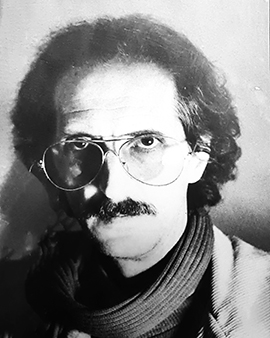


Gian Carlo Riccardi was born in Frosinone on October 21, 1933. The art critic Enrico Crispolti described him as a multimedia artist due to his ability and versatility to work in an interdisciplinary art fields, as a multimedia artist. He graduated in scenography in 1961 from the the Academy of Fine Arts in Via Ripetta in Rome in 1961 and later obtained a diploma in theater and film directing at the film directing at the Experimental Center in Rome. In the 1960s and 1970s, he worked for the RAI as an assistant to the set designer Cesarini Da Senigallia and at the same time as a cartoonist for satirical magazines such as magazines such as Il Travaso delle Idee, Simplicissimus and Il Bertoldo. As an author of texts and audiovisual works, Riccardi was part of the Roman theater avant-garde and worked with Memè Perlini, Carmelo Bene, Pino Pascali, Giuliano Vasilicò, Mario Ricci, Nino De Tollis, Filippo Torriero and others in the realization of avant-garde shows and festivals throughout Italy. In the 1970s and 1980s he associated with artists and writers such as Alberto Moravia, Cesare Zavattini, Libero De Libero, Umberto Mastroianni and Mario Lunetta. A considerable part of the artistic work by Gian Carlo Riccardi is characterized by drawings. A large part of his work is characterized by the of his work is oriented towards the abstract through the use of collages and readymades. In recent years Riccardi has recaptured the time of childhood by creating works that refer to childhood and the child. and the child. From the 1980s onwards, Riccardi realized so-called "Rooms", i.e. installations that he created from walls colored according to abstract motifs, wooden fragments and everyday objects. His works have been exhibited in solo and group exhibitions in Italy and abroad. abroad. Riccardi was also the author of narrative texts and screenplays. Gian Carlo Riccardi died in his hometown in 2015. Critics and writers such as Angelo Maria Ripellino, Elio Pagliarani, Nello Ponente, Vito Riviello, Giovanni Gigliozzi, Filiberto Menna, Cinzia Baldazzi and André Pieyre de Mandiargues have written about him.

Gian Carlo Riccardi was born in Frosinone on October 21, 1933. The art critic Enrico Crispolti described him as a multimedia artist due to his ability and versatility to work in an interdisciplinary art fields, as a multimedia artist. He graduated in scenography in 1961 from the the Academy of Fine Arts in Via Ripetta in Rome in 1961 and later obtained a diploma in theater and film directing at the film directing at the Experimental Center in Rome. In the 1960s and 1970s, he worked for the RAI as an assistant to the set designer Cesarini Da Senigallia and at the same time as a cartoonist for satirical magazines such as magazines such as Il Travaso delle Idee, Simplicissimus and Il Bertoldo. As an author of texts and audiovisual works, Riccardi was part of the Roman theater avant-garde and worked with Memè Perlini, Carmelo Bene, Pino Pascali, Giuliano Vasilicò, Mario Ricci, Nino De Tollis, Filippo Torriero and others in the realization of avant-garde shows and festivals throughout Italy. In the 1970s and 1980s he associated with artists and writers such as Alberto Moravia, Cesare Zavattini, Libero De Libero, Umberto Mastroianni and Mario Lunetta. A considerable part of the artistic work by Gian Carlo Riccardi is characterized by drawings. A large part of his work is characterized by the of his work is oriented towards the abstract through the use of collages and readymades. In recent years Riccardi has recaptured the time of childhood by creating works that refer to childhood and the child. and the child. From the 1980s onwards, Riccardi realized so-called "Rooms", i.e. installations that he created from walls colored according to abstract motifs, wooden fragments and everyday objects. His works have been exhibited in solo and group exhibitions in Italy and abroad. abroad. Riccardi was also the author of narrative texts and screenplays. Gian Carlo Riccardi died in his hometown in 2015. Critics and writers such as Angelo Maria Ripellino, Elio Pagliarani, Nello Ponente, Vito Riviello, Giovanni Gigliozzi, Filiberto Menna, Cinzia Baldazzi and André Pieyre de Mandiargues have written about him.
Page 1 / 1






